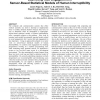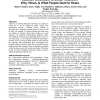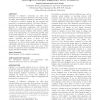85
Voted
CHI
2005
ACM
16 years 25 days ago
2005
ACM
In this paper, we present an attentive windowing technique that uses eye tracking, rather than manual pointing, for focus window selection. We evaluated the performance of 4 focus...
92
Voted
CHI
2005
ACM
16 years 25 days ago
2005
ACM
The computer and communication systems that office workers currently use tend to interrupt at inappropriate times or unduly demand attention because they have no way to determine ...
CHI
2005
ACM
16 years 25 days ago
2005
ACM
Email consumes significant time and attention in the workplace. We conducted an organizational survey to understand how and why people attend to incoming email messages. We examin...
101
click to vote
CHI
2005
ACM
16 years 25 days ago
2005
ACM
Using a mobile device in a social context should not cause embarrassment and disruption to the immediate environment. Interaction with mobile and wearable devices needs to be subt...
126
Voted
CHI
2005
ACM
16 years 25 days ago
2005
ACM
Online communities need regular maintenance activities such as moderation and data input, tasks that typically fall to community owners. Communities that allow all members to part...
103
click to vote
CHI
2005
ACM
16 years 25 days ago
2005
ACM
Advances in location-enhanced technology are making it easier for us to be located by others. These new technologies present a difficult privacy tradeoff, as disclosing one's...
77
Voted
CHI
2005
ACM
16 years 25 days ago
2005
ACM
Speed dependent automatic zooming (SDAZ) is a promising refinement to scrolling in which documents are automatically zoomed-out as the scroll rate increases. By automatically zoom...
96
Voted
CHI
2005
ACM
16 years 25 days ago
2005
ACM
Designers of children's technology are often more interested in user motivation than those who design systems for adults. Since children's technology often has aims such...
110
Voted
CHI
2005
ACM
16 years 25 days ago
2005
ACM
In this paper, we investigate how the choice of media for capture and access affects the diary study method. The diary study is a method of understanding participant behavior and ...
52
Voted
CHI
2005
ACM
16 years 25 days ago
2005
ACM
As human-computer interaction increasingly focuses on mediated interactions among groups of individuals, there is a need to develop techniques for measurement and analysis of grou...



